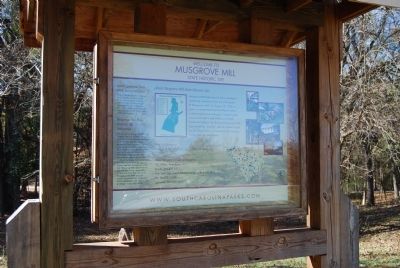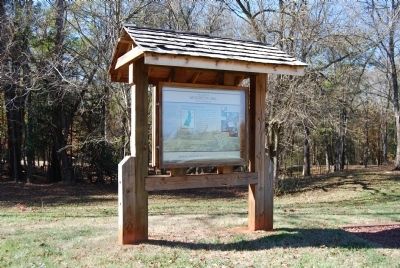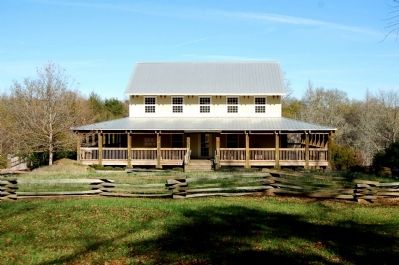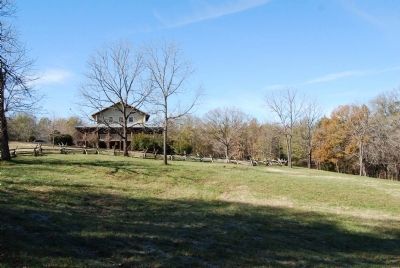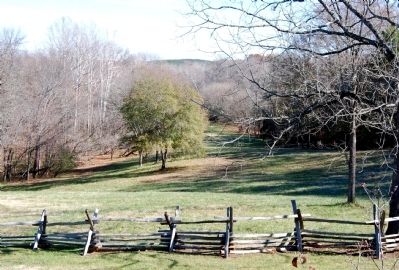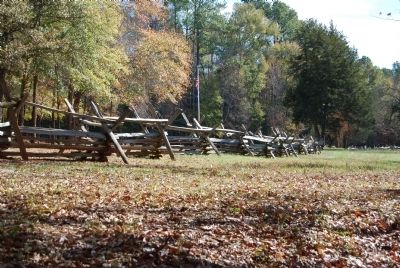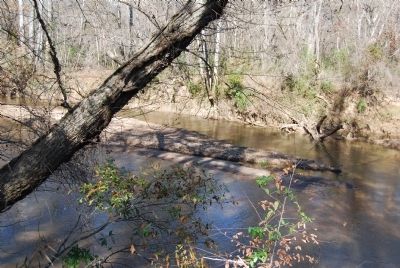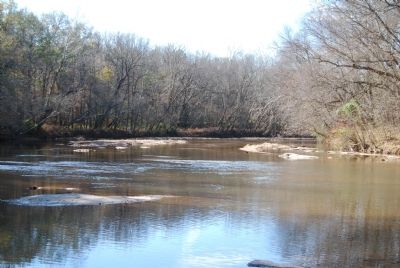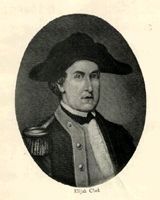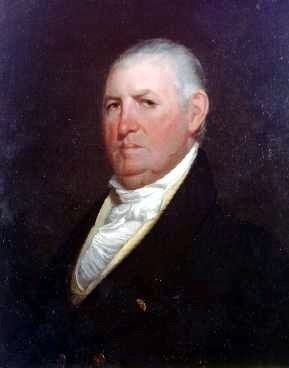Clinton in Laurens County, South Carolina — The American South (South Atlantic)
Musgrove Mill State Historic Site
Musgrove Mill State Historic Site is devoted to preserving a portion of the site of the Battle of Musgrove's Mill. On August 19, 1780, a small, yet battle-tested band of Patriot militia outmaneuvered and outfought a larger loyalist force compromised of both Militia and British Provincial Soldiers. The Battle of Musgrove's Mill epitomized the "guerrilla" type of warfare fought by the Patriot Militia in the Southern Campaign of the American Revolution.
South Carolina State Park Service Mission
To encourage people to discover South Carolina's state parks by protecing resource-based recreational and educational opportunities that emphasize the conservation, protection and interpretation of the state's natural and cultural resources.
Musgrove Mill State Historic Site Mission
The mission of Musgrove Mill State Historic Site is to protect, preserve, and interpret the cultural resources of the site for the education, enjoyment, and inspiration of the park visitor; primarily focusing on those historic resources associated with the American Revolutionary War Battle of Musgrove's Mill and the American Revolution in the Southern Colonies; and secondarily focusing on the broader span of human use and occupation of the site. Musgrove Mill State Historic Site will also foster stewardship of Revolutionary War resources throughout the state and will remain committed to promoting historic education and historic site protection and preservation.
Erected by South Carolina Park Service.
Topics. This historical marker is listed in these topic lists: Colonial Era • Patriots & Patriotism • War, US Revolutionary. A significant historical year for this entry is 1780.
Location. 34° 35.55′ N, 81° 51.15′ W. Marker is in Clinton, South Carolina, in Laurens County. Marker is on Musgrove Mill Road (State Park Road), on the right when traveling south. Touch for map. Marker is at or near this postal address: 398 State Park Road, Clinton SC 29325, United States of America. Touch for directions.
Other nearby markers. At least 10 other markers are within walking distance of this marker. Summer Camp (within shouting distance of this marker); No Rest for the Weary (within shouting distance of this marker); "Patriot in Petticoats" (about 500 feet away, measured in a direct line); Where There's a Mill… (about 600 feet away); Battle of Musgrove Mill (approx. 0.2 miles away); Ford Country (approx. 0.2 miles away); Into the Backcountry (approx. 0.3 miles away); Americans in British Uniform (approx. 0.4 miles away); A Band of Brothers (approx. 0.4 miles away); True to Their King (approx. 0.4 miles away). Touch for a list and map of all markers in Clinton.
Also see . . .
1. Musgrove's Mill Historic Battle Site. The battle of Musgrove’s Mill, fought on August 18, 1780, was an early American victory in the South during the Revolution. (Submitted on November 22, 2008, by Brian Scott of Anderson, South Carolina.)
2. Battle of Musgrove Mill. The Battle of Musgrove Mill, which took place on August 18, 1780, was one of the early turning points in the Southern Campaign of the American Revolution, and stands as an excellent example of the guerrilla conflict and civil war that raged near the Musgrove Mill on the Enoree River at the present day Clinton, South Carolina. (Submitted on November 22, 2008, by Brian Scott of Anderson, South Carolina.)
3. Col. Charles McDowell. Colonel Charles McDowell and his brothers, Joseph and William, were sons of Joseph McDowell and Margaret O'Neal, who emigrated from Ireland and settled in Winchester, Va. (Submitted on November 22, 2008, by Brian Scott of Anderson, South Carolina.)
4. Col. Isaac Shelby. Isaac Shelby (December 11, 1750 – July 18, 1826) was an American soldier and the first and fifth Governor of Kentucky, serving from 1792 to 1796 and from 1812 to 1816. (Submitted on November 22, 2008, by Brian Scott of Anderson, South Carolina.)
5. Battle of Musgrove's Mill (18 August 1780). On this march Sumter was joined by Col. James Williams, and also received instructions from Gen.
Gates to cooperate with him in the contemplated attack on the British forces at Camden. (Submitted on November 22, 2008, by Brian Scott of Anderson, South Carolina.)
Additional commentary.
1. The Battle of Musgrove Mill
In August, 1780, Col. Charles McDowell, of North Carolina, commanded about two thousand militia, who were stationed at Smith's ford, on Broad River, which was about fifteen miles below the Cherokee ford. Colonel Isaac Shelby, of North Carolina, commanded a regiment under General McDowell. The term of service for which the men had enlisted was just about expiring. It was ascertained that there were about seven hundred Tories camped at Musgrove's Mill, on the Enoree River, a few miles distant from the camp of Major Ferguson. Col. Shelby conceived the plan of breaking up this camp and routing the Tories. For this purpose, having obtained leave from General McDowell, he raised about seven hundred volunteers from the army, without regard to rank; very many field officers having volunteered, Col. Clarke, of North Carolina, was made second in command.
To effect their design, it was necessary that the affair should be conducted with both secrecy and dispatch. Accordingly, Shelby's force left General McDowell's camp on the 18th
of August, a short time before dark. They traveled on through the woods until dark, and then fell into the road and proceeded on all night, passing within three or four miles of Ferguson's camp, and going beyond it to the Tory camp at Musgrove's Mill. This post was forty miles from McDowell's camp.
Soon after daylight, when Shelby had arrived within half a mile of the camp, a citizen was taken prisoner, from whom he learned that the night previous the Queen's American regiment, commanded by Colonel Emines, from New York, had reached the post at the mill, and that the enemy were then from twelve to thirteen hundred strong. Just as this information was received, the enemy's patrol fell in with the advanced corps of Shelby's force. The patrol was immediately fired on, and driven in with the loss of seven men. This gave the enemy the alarm. Although the Tory force was so much larger than had been expected, neither Shelby nor his men thought of anything but meeting them. Ground was selected for an engagement, stretching at right angles across the road, about half a mile from the Enoree River. The army was formed, Shelby taking command of the right wing, and Colonel Clarke of the left. Colonel Williams, of South Carolina, was stationed in the road in the centre, though without a separate command.
Whilst the Tory force was forming, Shelby and his men were not idle. Immediately
after taking their places in line, and securing their horses, they commenced making breastworks of logs. In half an hour they had one breast high. So soon as this was completed, Shelby sent Capt. Inman, with a company of mounted men in advance, to make a false attack on the enemy. This feint was well executed. lnman and his men charged on the enemy, fired their pieces, and then, as directed, fled in apparent confusion. The enemy's centre, on whom the false attack had been made, seeing the flight of this force, immediately pressed forward in pursuit, in considerable disorder, shouting, "Huzza for King George.'' On approaching the breast-work, they were unexpectedly met with a deadly fire. The superiority of the enemy in numbers emboldened them to press forward their attack, not withstanding the advantage which our troops possessed by the breast-work. After an hour's hard fighting, the left wing of the enemy, composed of the Queen's regiment, drove our right wing, under Shelby, from their breast-work. Our left wing, which was opposed by the Tories, maintained its position. The battle was maintained some time longer, the right wing gradually giving way, whilst the left flank retained its connection with the centre at the breast-work. At this juncture, Col. Clarke sent his reserve, consisting of forty men, to Shelby's aid. Shelby thereupon rallied his men and ordered a charge, which
was well seconded by officers and men, and the enemy were broken and fled in confusion. The rout now became complete along the whole line, and the enemy were pursued to the Enoree River, with great slaughter. Above two hundred of the enemy were killed, and two hundred prisoners were taken. On our side, Capt. Inman, who had conducted himself most gallantly, and thirty men, were killed.
The broken forces of the enemy having crossed the Enoree, it became necessary to follow up the pursuit on horseback. Shelby called back his forces, and mounted with the intention of pursuing the scattered Tories, and then turning against Fort Ninety Six. While consulting with Col. Clarke, a messenger arrived from General McDowell, bringing a letter from Gov. Caswell to McDowell, informing him of Gates' disastrous defeat at Camden, on the 16th of August, and advising all officers commanding detachments to retreat, or they would be cut off.
Col. Shelby, perceiving the hazardous position in which he was placed by this unexpected calamity, with Cornwallis in front and Ferguson on his flank, immediately ordered a retreat. Taking his prisoners with him, he traveled all that day and the ensuing night, without rest, and continued their march the day succeeding, until an hour by sun, when they halted and fed their horses. Although they had thus been marching and fighting incessantly for forty-eight hours, the indomitable energy of their commander permitted his troops no rest, when there was danger of losing all by delay. Halting, therefore, no longer than was required to feed their horses, the line of march was resumed. It was well it was so; for the news of the defeat of the Tories at Musgrove's Mill had reached Ferguson, who had dispatched a strong detachment to intercept Shelby and release his prisoners. By making a hard forced march, this detachment reached the spot where Shelby and his men had fed their horses within thirty minutes after they had left it. But not knowing precisely how long Shelby had been gone, and the detachment being entirely exhausted, the pursuit was relinquished and Shelby reached the mountains in safety with his prisoners. The time of service of the men having expired, and there being no opportunity of doing any immediate active duty by a partisan corps, when they reached the road which led to Col. Shelby's residence, he and the men from his neighborhood returned home; the prisoners being left in charge of Colonel Clarke. After going some distance, Col. Clarke in like manner returned home, giving the prisoners in charge of Col. Williams, who conducted them to Hillsborough. At this place Col. Williams met with Gov. Rutledge, who, finding him in charge of the prisoners, supposed he had commanded the expedition in which they were taken, and as a reward for tho gallant achievement gave him a brigadier general's commission. Without detracting from the merits of Col. Williams, who was a gallant officer, is it right to say that this is an example too frequent in military history, where the rewards of a bold achievement fall on the wrong shoulders? Col. Shelby described the battle at Musgrove's Mill as the hardest and best fought action he ever was in. He attributed this to the great number of officers who were with him as volunteers. Considering the nature of the march and the disparity of numbers, the action at Musgrove's Mill must be considered as one of the most brilliant affairs fought by any partisan corps during the revolution. (Source: The Annals of Newberry: In Two Parts, John Belton O'Neall, John Abney Chapman, (1892), pages. 263-266.)
— Submitted November 22, 2008, by Brian Scott of Anderson, South Carolina.
2. Battle of Musgrove’s Mill Historic Site
The Battle of Musgrove’s Mill occurred on the rising ground north of the Enoree River, at Musgrove’s Ford, near the present-day Spartanburg County line, and immediately east of Cedar Shoals Creek. Early 18th century maps indicate that Musgrove’s Ford was between the mouth of Cedar Shoals Creek and a large bend in the Enoree River. The old 18th century
road running northwards from the ford is in approximately the same location as present-day Highway 56. The temporary fortifications built by Colonels Shelby and Clarke were about ¼ mile north of the ford along the highway.
Edward Musgrove’s house and mill, where the British garrison was located, was on the south side of the ford, opposite the battlefield. No above-the-surface evidence of this structure remains.
The nominated property includes the land north of the Enoree River ford, from Cedar Shoals Creek and an improved county road (S-10) east across Highway 56 to a small creek running parallel to the highway. Several houses lie along US Route 56 north of the river. Most of this land is heavily wooded with pines and hardwoods, and it slopes steadily down towards the Enoree River. The floodplains that run parallel to the river are sparsely vegetated except for large hardwood trees on the river’s edge. There are evidences of an old roadbed, crossing Cedar Shoals Creek about 700 feet from the Enoree River, but this road is not the same road that crossed the river at Musgrove’s Ford. The ford was possibly used by American scouts in crossing the creek and river to spy on the British camp.
The nominated property also includes a triangular portion of land south of the Enoree River, opposite the mouth of Cedar Shoals Creek, where Musgrove’s Plantation house
was standing until it burned in 1971. A dirt road leads from S.C. Route 56 north to the house site, in a cleared area adjacent to a man-made pond. This is the area where the British and Tories were encamped at the time of the battle.
Significance
The Battle of Musgrove’s Mill, fought on August 18, 1780, was an early American victory in the South during the Revolution. American troops routed a combined detachment of British and Tories at a ford on the Enoree River but were forced to retreat to the mountains of North Carolina when Loyalist forces converged on the area after the American defeat at Camden. The American militiamen used their superior marksmanship and knowledge of the terrain to surprise the British. This indicated a weakness in the British hold on the backcountry.
In 1780 the British established a fortified post at Musgrove’s Mill, home of Major Edward Musgrove, on the south side of the Enoree River. A regular garrison of 200 men under a Major Fraser was stationed there. By August 17 the garrison has been reinforced by Abraham de Peyster of the King’s American Regiment, David Fanning and his North Carolina Tories, and Colonel Daniel Clary with his Tories from upper South Carolina. A detachment commanded by Lt. Colonel Innes had a company of the New Jersey Volunteers and a captain’s command of de Lancey’s New York Royalists. Colonel Patrick Ferguson, leader of the Tories in South Carolina, has sent wounded to the post, bringing the total detachment to about 500 men. In addition some 100 Tories of the South Carolina Regiment were camping nearby.
The American Colonel Charles McDowell of North Carolina has established a camp at Cherokee Ford, just across the South Carolina line. Believing that the British post at Musgrove’s Mill was vulnerable, McDowell decided to attack. His forces included troops led by Colonels Isaac Shelby and Elijah Clarke, from North Carolina and Georgia, and the remnants of the old Ninety Six Brigade under Colonel James Williams of South Carolina.
The American officers formed a joint command and set out just before sundown on August 17 with about 200 men. They rode cross country for 26 miles from Smith’s Ford to Brandon’s settlement in Fairforest and then 12 to 14 miles to within a mile of the British camp across the Enoree River. Knowing the countryside through which they passed, the Americans managed to avoid the Tory posts.
After establishing camp the Americans sent out scouts to spy upon the British. They came upon a Tory patrol, and a skirmish occurred. As a result the Americans moved their camp onto a timbered ridge above the ford about ½ mile from the river.
Because of information from local sympathizers concerning the strength of the British post, the Americans decided not to attack, but instead to set a trap for the British that would draw them across the river and into a fortified line of fire.
The fortifications consisted of a breastwork of logs and brushwood, in a semi-circle along a wooded ridge. Shelby’s troops occupied the right portion of the breastworks, Williams’ the center, and Clark’s the left. Twenty horsemen were concealed behind each flank of the breastworks, and 40 men were held in the rear as a reserve.
At the Loyalist camp across the river, Major Innes’s arguments for attach prevailed, even though a 100-man patrol had not returned. Leaving 100 men in camp as a reserve, 300 British troops and Tory militia prepared to cross the river.
Meanwhile, on the American side, Captain Shadrack Inman was sent forward with about 25 mounted men to provoke the Tories and draw them across the river into the line of fire from the American breastworks. The plan worked; the British, believing they were driving Inman’s men back, saw the American fortifications, formed into a battle line, and advanced. The Americans waited to fire until the British were within 70 yards; as a result, they inflicted many casualties. The British and Tories charged again, driving some of the Americans from the left wing of the breastworks, but the American reserve force stopped their advance. Innes, the British commander, was badly wounded. Shelby’s Americans drove the British and Tories back from their defenses, and the British retreat became a rout. When the Tory patrol finally returned to the post, the Americans had already left with their prisoners.
The British and Tories remaining at the post decided to retreat to the fort at Ninety Six, 30 miles to the southwest. They received word, however, that the main American force at Camden had been badly defeated and that British reinforcements would be arriving shortly. The Americans received the same news, and hastily set out through the woods with their prisoners, moving in a northwesterly direction. The Americans continues their retreat through the night and into the next morning, traveling sixty miles from Musgrove’s Mill and into the mountains of North Carolina.
In this battle, British losses included 60 killed, 90 wounded, and 70 taken prisoner. Four Americans were killed and nine wounded. This American victory has been attributed to American fortifications and knowledge of the terrain, the underestimation of American strength by the British, and the superior marksmanship of the American frontiersmen. Occurring at the same time as the American defeat at Camden, this victory gave the American cause a badly needed boost in morale. (Source: National Register nomination form.)
— Submitted August 6, 2009, by Brian Scott of Anderson, South Carolina.
Credits. This page was last revised on November 22, 2020. It was originally submitted on November 22, 2008, by Brian Scott of Anderson, South Carolina. This page has been viewed 1,779 times since then and 35 times this year. Photos: 1, 2, 3, 4, 5, 6, 7, 8, 9, 10. submitted on November 22, 2008, by Brian Scott of Anderson, South Carolina.
